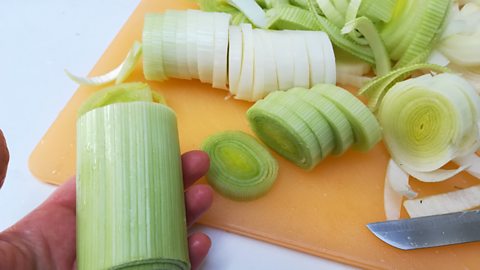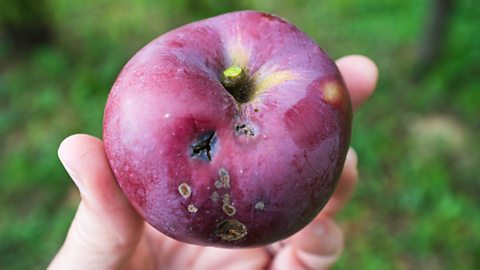Are you throwing ТЃs worth of soft veg and wrinkly fruit in the bin needlessly?

by Polly Weeks
From the tougher dark-green part of a leek, to a potato that feels soft, to a plum that has gone wrinkly, do we (well, I) throw away too much fruit and veg?
Every evening youтll find me in the kitchen. Iтm the cook in our house and I think of myself as a pretty adventurous meal maker т Iтm happy to experiment with different combinations of ingredients. But I have one major cooking flaw: Iтm anxious about using foods that donтt look at their best.
Iтm the kind of person who receives eye-rolls from elders when I chuck out ingredients that are past their use-by date. I can sometimes be found in the corner peeling mushrooms тjust to be sureт thereтs no soil left on them. Find a dodgy looking hole in an apple? Iтm not going to тeat around itт. And as for the three-second rule? Absolutely not. No way. Not under any circumstances. (Though Iтm pretty sure Iтm right about that one!)
тIs it normal to do this?т, I frequently ask myself, as I chuck out the layer of onion beneath the brown skin because itтs still brown and green in places.
Iтm keen т like Iтm sure a lot of people are т to make each ingredient go as far as possible. So, in a bid to find out which foods should go straight into the brown bin and which Iтm unnecessarily throwing away, I spoke to an expert.

Meet the expert: Helen White is a special advisor on household food waste for charity WRAP (Waste and Resources Action Programme). She works with food retailers, manufacturers and brands on engaging with the public to reduce food waste.

Learn how to store root veg and the best recipes for using up your leftovers.
Can I eat wrinkly fruit?
I try to not let food reach this point, but sometimes itтs taken out of my hands. For example, some plums I recently bought werenтt ripe, so I left them to soften, but they remained rock hard until they were suddenly very wrinkly т there was nothing in-between. I tried a plum that was perhaps a day behind the wrinkly ones, and it was still hard and bitter. I ended up throwing them all away. But would the wrinkly plums have been fine to eat? The same applies to other stone fruit, such as nectarines and peaches т should I consign them to the food bin?
EXPERT ADVICE: тFirst things firstтІ most fresh produce, including plums, will last longer in the fridge, which needs to be set to <5ТАC. This is so important, Love Food Hate Waste (a section of WRAP) has created a . Some fruits, such as pears and avocados т or indeed plums т sold as not fully ripe, need ripening at room temperature (although I think weтve all had the experience of missing the 15 minutes when something went from unripe to over-ripe!). If itтs just wrinkly, it should still be fine (to eat). If itтs mouldy, itтs not. Add wrinkly fruits to smoothies or salsas or cook them т Iтm thinking plum compote or dipping sauce, red pepper soup or stuffed peppers, even roasted grapes are delicious added to a salad.т
What can you do with fruit and veg thatтs gone soft
Sometimes fruit and veg goes soft and starts to taste floury т especially potatoes and apples. I try to use them in alternative ways, for instance in apple sauce or mashed potatoes, where the textureтs less important. Equally, Iтll buy a bag of root veg т say carrots or parsnips т and will have used almost all of them, but thereтs always one or two left that go bendy and have hair-like wisps growing off them. Is there a way to get the texture back to how it should be and are they still ok to eat once cooked?
EXPERT ADVICE: тAgain, storage is important for keeping your food in good condition. Maincrop potatoes should be stored in a cool, dark, dry place to keep them at their best. Forget the fruit bowl for apples: keep them in the fridge, you will be amazed at how long they stay fresh and crisp in there. If they do go floury, cooking is the best option. Add apples to a smoothie, or even a curry, or a pickle or chutney, or stew them for a pie or crumble filling. If youтre making mashed potato (because you have potatoes that need using up), freeze it in portions, ready to defrost when you need it. For roast potatoes, keep the peel (for crispy potato peeling crisps) and make the most of the texture for a really crispy roasty. For sprouting veg, eat as much as is edible and cut off the sprout/eye. Iтve had decent results planting very sprouty onions and potatoes in the garden.
тYou can also try reviving bendy root veg. A cold bath can re-invigorate them in much the same way as a person! Ideally, cut off a bit of the root end (but this is not essential), then either stand the veg in a glass of very cold water or arrange them in a dish of iced water in the fridge to see if they perk up.т
What to peel and what not to peel?

Iтm not talking potatoes here т Iтm definitely a skin-on mash/fries type. But there are some veg I canтt bring myself to leave unpeeled. Take the humble onion: I remove the brown peel but then sometimes the first layer of onion too, as itтs still brown in places or dark green. Should I bother doing this? And Iтm even more fastidious about fungi: I peel mushrooms as a matter of course, to ensure there is no soil on them.
EXPERT ADVICE: тDidnтt someone once say тlife is too short to stuff a mushroomт? I feel the same about peeling. Mushrooms need a wipe with a tea towel or a piece of kitchen paper to remove the dirt, thatтs all. Washing makes them go slimy. As for the onion, in my experience (the browning) is usually just around the top, so I cut any brown off when I take off the top and root. Look, no-one expects you to eat things that arenтt edible (such as teabags, eggshells and onion skin), so donтt punish yourself: eat whatтs edible and put the inedible in your food waste bin.т
Where to draw the line with roots, leaves and tops

The knobbly bit at the end of a carrot, the white part near the stem of a pepper, the trimmings from green beans and sugar snap peas. Hand me a veg knife and I will chop, chop away. When thereтs colour changes, Iтm even тworseт. With leeks I use the white and light green section, but the tough dark-green part goes straight in the food bin. And while theyтre not tough, I do the same with the dark-green part of a spring onion. Do I need to do this? It seems wasteful to see a quarter of a leek head into the food bin.
тWe call the solution to this тcompleatingт! Here are some examples:
- You can eat cauliflower and carrot leaves, sprout tops, broccoli stalks, cabbage hearts and herb stalks. With all these itтs about what you do with them. So for herb stalks (because they are a little more robust), chop them into dips and sauces or onto savoury dishes or blitz them into pesto. I (freeze) parsley stalks for flavouring soup and stock.
- The green ends of leeks and spring onions are full of goodness and flavour. You can use them in the same way as you use the white bit, just wash them thoroughly.
- You donтt need to peel beetroot when roasting it: the skin is great and you can use the leaves as you would chard or spinach.
- Roasting young butternut squash with the skin on adds flavour and texture.
тA lot of chopping off of the ends is about personal preference rather than flavour; so if itтs edible, eat it, if itтs not, put it in the food waste bin.т
Root veg and mushrooms that start to feel wet
Iтm thinking primarily of things like root veg here т like carrots that seem to emit a watery liquid after a while (especially if left in a bag). And the absolute worst т mushrooms that not only have a wet liquid but get a fishy smell. When you get тthe smellт, is it time to put them in the food waste bin? How about mushy fruit and veg, such as onion thatтs gone soft?
EXPERT ADVICE: тIf itтs mouldy, rotten or smelling bad, donтt eat it. The key here is to stop them getting wet to begin with. What youтre seeing with carrots is тtranspirationт, where they lose moisture in the dry atmosphere of the fridge (yes, the fridge is a dry place). So, again, better storage can help. We advise keeping most fresh produce (except bananas, onions, uncut pineapples and potatoes) in the fridge at <5ТАC, and in the original packaging, as this can help keep it fresher for longer. For some items, such as salad leaves, we suggest once youтve opened the bag you add a piece of kitchen paper to it. You could try putting carrots into a lidded container. Mushrooms tend to fare better in a paper bag, but you might not buy them like that, so you could try tucking them into their punnet with a folded tea towel, like a blanket.
тOne thing to consider might be how much fresh produce you are buying (and how long you expect it to last). тNot used in timeт is the main reason given for wasting most fresh produce, so are you buying too much? Choosing loose, or smaller, or frozen veg can help you buy only what you need and reduces the chance of you not being able to get through your fresh produce before itтs past its best.т
Can I eat bruised fruit and veg?

Iтm getting much better at cutting out a bad bit of fruit and veg and then cooking the rest or eating it raw. But is this OK? And what if thereтs a hole in the produce that looks like itтs been created by an insect, for instance a maggot in an apple?
EXPERT ADVICE: тIf, on inspecting a hole, thereтs someone still at home, it can be a bit off-putting! But you do right by cutting out the bruise, bad bit or hole and using as much of the rest as you can.т
The changes Iтve made
Following Helenтs advice, Iтve become determined to cut my food waste. The first advice I took was to stop being so wasteful with roots and tips. My leeks are now fully utilised. Iтve gone from removing all the leaves on broccoli and cauliflower to cooking the ones nearest to the florets. I love the tip about straightening up those bendy veg, it feels slightly like a science experiment when bringing them back.
I also feel less guilty about throwing away some bits that genuinely canтt be used. No longer do I worry that I shouldnтt put the brown onion skin in the food waste bin т I know there are some that I can indeed throw away.
Iтm also trying my best not to let fruit and veg get old. One way of doing this is to cook meals while they're still at their best, and put them in the freezer. Recipes for versatile vegetable stew and versatile vegetable soup are great for using up any veg. I also sometimes make vegetable stock using veg and even some peelings, and then put it in the freezer.
My next hope? To experiment more. Nadiyaтs anyone?